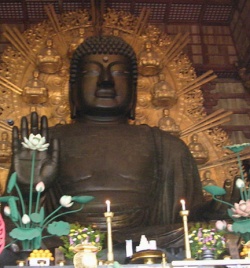Age of the end of the dharma
age of the end of the dharma (masse 末世, mappō 末法)
Both Japanese terms given here stand for the "era" or "age" (se 世) of the "end" (matsu 末) of the "dharma" (hō 法). In the Mahayana Buddhism of East Asia there is a widespread belief in the gradual degeneration of the Buddha's dharma (teachings), which is said to progress through three phases. The first one-thousand year (or, in a variant scheme, five-hundred year) period following the death of the Buddha is said to have been the "age of the true dharma" (shōbo 正法), during which time his followers were able to practice in accordance with his teachings and thereby attain awakening. The next one-thousand year period is called the age of the "semblance dharma" (zōhō 像法), in which practice of the dharma continues and things look good on the surface, but spiritual corruption has set in and true attainment no longer occurs. The third and final period, ten thousand years in duration, is styled the "age of the end of the dharma." During this final age, which proponents of the theory in medieval China and Japan calculated was upon them, the teachings of Buddhism survive but the actual practice of the dharma has died out and nobody is able to attain awakening.
Belief in the age of the end of the dharma was rampant in Kamakura period (1185-1333) Japan, when it helped to fuel the rise of Pure Land movements which claimed that trying to attain salvation through one's "own efforts" (jiriki 自力) was hopeless in this degenerate age and that one should instead rely on the "other power" (tariki 他力) of the Buddha Amida. Dōgen and Keizan put no stock in theories that denied the value of traditional modes of Buddhist monastic practice, but neither did they entirely reject the notion of three stages in the evolution of the dharma. One eko text in which the "age of the end of the dharma" is mentioned suggests that, in the present degenerate age, it is Dōgen and Keizan whom ordinary beings (including their descendants in the Soto lineage) should rely on. Another eko text appeals to the arhats to "turn the age of the end of the dharma (mappō 末法) into the age of the true dharma (shōbō 正法)."
